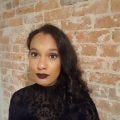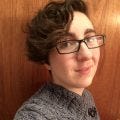INTERSECTIONALITY: A #DVPIT Blog Hop Roundtable Discussion (Part 1 of 2)
Introduction by Saba Sulaiman

Hi, everyone! I’m thrilled to kick off this cycle’s #DVpit blog hop here on Pub(lishing) Crawl with our #DVpit Roundtable, where we gather around with some wonderful publishing professionals and hear them share their infinite wisdom! Thank you, Beth for inviting me to moderate this discussion, and thank you to our incredible panelists for generously volunteering their time and expertise.
The topic for today’s roundtable is Writing Overlapping Identities: The Importance of Intersectionality and How it Informs Character and Consequence.
Please welcome our esteemed panelists:
Agents: DongWon Song at Howard Morhaim Literary and Amy Bishop at Dystel, Goderich & Bourret LLC.
Editors: Tiffany Shelton at St. Martin’s Press/Macmillan and Rachel Stark at Sky Pony Press.
Learn more about them at the bottom of this post!
[hr]
Intersectionality, first coined by Kimberlé Crenshaw, is a term that has been floating around a lot on social media recently, especially in the wake of recent political events and the general rise of social justice consciousness. Not many people know, however, that it was coined almost 30 years ago to indicate how different identities and forms of discrimination can overlap to increase the magnitude of an individual’s disadvantages in society. Now, it’s being used as a catch-all term to rally for more inclusivity and nuance when it comes to discussing the ways in which people can be marginalized, which includes one’s gender, sexuality, race, ethnicity, social class, physical/mental ability, education level, age, and even language and culture.
But what do we mean by intersectionality in the context of publishing? How do we account for it while writing well-rounded characters, and, most importantly, how do we incorporate intersectionality into our projects from a craft perspective? Is it something that industry professionals are even thinking about or considering when it comes to building their lists, or are these conversations only happening on social media? And why, if at all, are these conversations important?
We are lucky to be joined by our wonderful panelists, who not only tackle these questions head on, but do so with candor and grace. Without further ado, let the discussion begin!
Q1: What does it mean to write characters with intersectional identities? Can you give us some examples of books you think have incorporated intersectionality successfully?
DongWon: Hi, I’m DongWon Song and I’m an agent at Howard Morhaim Literary.
This is such an interesting question and it's one that we, as industry, have historically failed at addressing. I've been racking my brain for good examples of books that do a good job of representing intersectional experiences well and have been drawing a big ole blank. But, to back up, the way I see intersectionality playing out are character portrayals that resist the usual stereotypes we project onto people of color, or any group, really. It's recognizing that the human experience is wider and richer than what the dominant narrative wants us to acknowledge. So a character can be a person of color and queer at the same time. A character can be queer and fat. One marginalization doesn't negate another.
Now, there's a lot of nuance in how that plays out and I think it requires an even deeper understanding of the underlying issues and ways certain representations can be harmful. I think the push for diversity often gets reduced to the simplest form or the most expected paths. This leads to a lot of books that foreground Black pain or feature nerdy Asians or any number of problematic stereotypes. Representation requires dimensions and depth and that often gets lost in the rush to publish a work from a "diverse" author or featuring "diverse" protagonists.

Amy: Hi! I’m Amy Elizabeth Bishop, and I’m an agent at Dystel, Goderich & Bourret.
Dong Won, I really like what you’re saying about intersectionality recognizing that the human experience is wider and richer than the “mainstream” narrative acknowledges. I also feel that intersectionality at its best should showcase the complexity of human nature—none of us are one-dimensional or defined by just one thing. Intersectionality should seek to include more people in the narrative and push back against the very human inclination to put people in neat little boxes. So, in writing characters who are intersectional, you want to think about the variety and nuance that any group of people has within it, and expand on that. Often easier said than done, certainly! And, unfortunately, I confess that I’m also coming up short on examples of books, as much as that pains me!

Tiffany: Hi! I’m Tiffany Shelton, and I’m an editor at St. Martin’s Press.
Amy, I can't tell you how often I say we aren't defined by just one thing especially as a multiracial woman from the lower middle class.
DongWon, I agree with you that the push for diversity often leads to books that feature problematic stereotypes like Black pain or nerdy Asians, and it's the narrative that's been fed to us for decades, if not centuries. People of color go through some of the same issues and life changes that Caucasians do. We graduate high school, college, and even post-grad; we get married, have children, grandchildren, etc...but we are hardly ever portrayed as being able to celebrate the joys and milestones in life without the stereotypes associated with us being thrown in—for example, an Asian character who is successful in their field but disappointed their parents by not going into medicine or law or tech (why can't their parents be happy for them?)
I agree with you both that it is difficult to find examples of books that explore intersectionality well without stereotypes. The few times we see marginalized characters (i.e. queer, fat, disabled), it's more often than not from the Caucasian perspective. And I'm not saying that their voices aren't warranted or needed, but they still have some level of privilege from being Caucasian that intersectional people of color don't. But I hope with the success of PoC narratives in other mediums (such as Black Panther), that we we start to see more narratives that celebrate intersectionality without resorting to stereotypes.

Rachel: Hi! I’m Rachel Stark, and I’m an editor at Sky Pony Press.
What all three of you have said about the need for stories that speak to the specificity of people's individual identities—and how telling these stories helps us better reflect the depths, breath, and range of experiences outside of the dominant narrative—resonates a lot with me. I agree with DongWon that it often feels like the industry has been slow to discover and share stories that don't reduce characters to a single identity or fall into stereotypes. I will say that I am hopeful that we're going to see more intersectional stories over the next several years—in no small part because of the hard work that's gone into building movements like #DVpit. I'm just getting home from the launch event for Emily X.R. Pan's The Astonishing Color of After, for instance, and that feels like a good example to throw out here. I'd also add Isabel Quintero's absolutely fabulous Gabi, A Girl in Pieces, Fox Benwell's Last Leaves Falling, and a book I foist on just about everybody who will stand still and listen to me, Nnedi Okorafor's Who Fears Death. As an industry I think we have a ton of work to do in terms of publishing books that really reflect how varied the experiences and identities that have historically been sidelined are, but I'm excited to be in publishing at a time when books like these are finding an audience.
Q2: Has the topic of intersectionality come up at your workplace, especially in terms of the stories you want to see on your lists? How relevant is it in the publishing landscape, if at all?
Tiffany: It definitely has. In fact, I was just talking with a coworker about how we wish we were seeing more intersectional stories in our submissions—especially with them being one of the few, if only, queer junior level editors and me one of two PoC in the editorial department, both of us women. We would love to see and experience stories that we can relate to. But that example shows how it's being discussed, on an informal one-on-one basis. Do I think the publishing as a whole is focusing on finding intersectional stories? Not in the same way they are focusing on the general diversity movement. I think, as of right now, if it checks one box (either PoC, Queer, or, rarely if ever, overweight) that's good enough for them. And I do think it has a lot to do with the industry being predominantly White and heterosexual. That doesn't mean that there aren't White heterosexual editors looking for intersectional stories, it just means that it's easier for these stories to get glossed over.
Amy: We’ve certainly discussed intersectionality at work and I think many of us are trying to actively incorporate it into the stories we seek out, even if we’re not talking about it with others. Certainly, as Tiffany mentions, I think those of us who are a minority tend to be more acutely aware of intersectional stories or seek them out, as we look for stories that represent (on some level) our experience, but I think (and hope) this is becoming more prevalent overall. I have personally felt overjoyed to read stories that have a more Asian influence (in all genres) and to see covers with people who look like me (or more like me) and I hope that more and more marginalized readers can experience the same joy. It does start with us, in a way—I hope that if writers know we’re embracing these stories, they’ll step forward to tell theirs.
Rachel: Like both of you, I am actively seeking intersectional stories, and hearing from many of my colleagues that they are as well. But also like both of you, I'm finding that the conversations I have about intersectionality tend to be one-on-one, and frequently with others who are more likely to share my views—often people from marginalized groups in more junior positions, who may have the power to build their own list but likely don't have the power to change policies to insist on a more inclusive overall publishing program (for instance).
These conversations are hard, and a lot of the nuance can tend to disappear in larger groups—acquisitions meetings, sales conferences, covers, large-group planning for promotions and lead titles, etc. I think some things have gotten better—in the last five to ten years I've seen the tone shift from trying to downplay anything that made a protagonist different from a white/straight/male default to actively playing those things up as selling points—but the conversation is still oversimplified in a way that I think can be harmful to discussions of certain particular facets of identity, and that renders good discussions of intersectionality almost impossible.
I think Tiffany's right that a lot of this comes from publishing houses being relatively heterogenous—and more than that, we are majority White, and a huge (often unspoken) part of White culture is that we consider it deeply rude to be asked to sit with discomfort. We are still so bad at effectively acknowledging, much less portraying, difference, because it makes us so uncomfortable to do so. And I think it's too easy, in a large room, for a group of people who feel uncomfortable, to dismiss an important topic like this one.
But you're so right, Amy, that we can embrace awesome, intersectional stories, and help encourage more writers to trust us with stories like them. And I think if we're having these conversations one-on-one with the people at our level, there will come a day when we're the ones having that large-group discussion, and it's going to be really fruitful.
DongWon: From the agenting side of things, I don't know that I've had a lot of direct conversations with colleagues at the office about this. I tend to find myself having these conversations in meetings with editors over lunch or coffee. Especially when I get to sit down with another person of color, we are able to have a conversation that feels a lot more nuanced and at the level where intersectional issues and more complex representation is something we're really able to dig in to.
Intersectional representation should play a bigger role as we continue to move the diversity conversation forward. I think there's a lot of frustration on the part of the author community and among some readers that publishing still hasn't caught up to where the discussion is at. The problem is that publishing is fundamentally a slow moving business. Books take time to write. Once they're acquired it can take at least a year before they hit the shelves. The conversation is moving forward, but at a pace that can feel glacial.
That said, I do find a more varied range of representation starting to show up and, as we write this, there are several women of color on the NYT YA Hardcover list and that feels very special. As that feels more common and more part of the expected publishing landscape, I hope we'll also start to see more intersections between the kinds of representation we can expect from what's being published.
[box type="info"]Thank you so much for joining us for Part One. The Intersectionality Roundtable continues tomorrow with Part Two![/box]
About the Panelists

DONGWONG SONG is an agent at Howard Morhaim Literary Agency representing science fiction and fantasy for adults, young adult, and middle grade readers as well as select non-fiction. He was formerly an editor at Orbit and a product manager for the ebook startup, Zola Books and has taught as an adjunct instructor in the publishing program at Portland State University. You can find him on his website or on Twitter.

AMY ELIZABETH BISHOP joined Dystel, Goderich & Bourret in 2015 after interning for them in 2014. In addition to her own client list at DG&B, Amy assists the president, Jane Dystel, and oversees the office and the interns. She reads widely, but her main interests at this time include upmarket women’s fiction, fiction from diverse authors, voice-driven historical fiction from different perspectives, and stories with a Victorian Gothic flair. In terms of nonfiction, she’s eagerly on the hunt for narrative nonfiction that addresses issues of politics, social justice, feminism or targets a millennial audience. She also loves historical narrative nonfiction that dives into untold stories. You can find her on Twitter.

TIFFANY SHELTON is an editorial assistant at St. Martin's Press and she recently acquired her first young adult suspense novel for their Wednesday Books imprint. She's interested in acquiring young adult novels across all genres especially if they feature diverse characters, cultures, or a diverse author. She's also looking in the adult space for her next favorite romantic comedy, the thriller that will keep her up at night, or the next historical that will transport her back in time. When she's not rewatching Belle or swooning over Taylor Kitsch in Friday Night Lights, she's dreaming of the day she'll have a normal sized kitchen to bake to her heart's desire. You can learn more about Tiffany on her website or follow her ramblings on Twitter.

After five years in children's book marketing, including stints at Simon & Schuster and Bloomsbury, RACHEL STARK joined Sky Pony Press as an editor in 2015. She edits literary fiction, graphic novels, and licensed books for the middle grade and young adult markets. Some books she’s worked on include The Unbinding of Mary Reade by Miriam McNamara, Cookie Cutters & Sled Runners by Natalie Rompella, and Crossing the Line by Bibi Belford. Twitter: @syntactics

SABA SULAIMAN is an agent at Talcott Notch Literary Services, a boutique agency located in Milford, CT. She holds a BA from Wellesley College and an MA from the University of Chicago, where she studied modern Persian literature. She is looking primarily to build her Middle Grade and Young Adult lists, and is particularly interested in contemporary realistic stories. She’s also open to category romance (all sub-genres except paranormal), literary, upmarket, and commercial fiction, tightly plotted, character-driven psychological thrillers, cozy mysteries à la Agatha Christie, and memoir. Being a first generation immigrant who is constantly negotiating her own identity and sense of belonging in a place she now calls “home,” she is committed to highlighting more diverse voices with compelling stories to tell; stories that demonstrate the true range of perspectives that exist in this world, and address urgent and often underexplored issues in both fiction and non-fiction with veracity and heart. You can learn more about Saba on her website or follow her on Twitter.
[box type="note"]Edited to credit the creator of the term "intersectionality.[/box]
SaveSave
SaveSave
SaveSave
